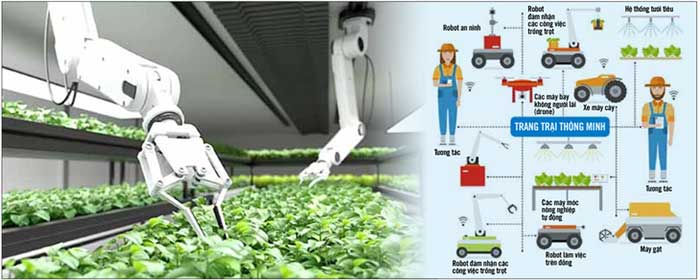To mitigate the negative impacts of unpredictable weather conditions, reduce labor burdens, and ensure food security, several countries have begun to utilize robots and technology in agricultural production.
Far removed from traditional farms, a unique farm located in Compton, Los Angeles County, California (USA) operates without soil and human labor, relying solely on robots.
Automation Process
According to the BBC, the farm is owned by Plenty Agriculture Company and serves as a practical example of a fully automated farming model that does not require human involvement.
Experts are optimistic that these “smart” farms will alleviate labor shortages, expand cultivation areas, and increase crop yields regardless of weather conditions, thereby ensuring food security for humanity.
At this farm, every step of the production process, from nurturing seedlings to distributing the products, is automated without any human intervention.

Robot arms planting vegetables instead of humans – (Image: Freepik – Graphics: Depositphotos – Vietnamese translation: UYÊN PHƯƠNG)
Initially, the seeders drop seeds into trays filled with coconut coir instead of traditional soil. Once the seeds germinate, these seed trays are transported to a spacious germination room.
Here, the young plant sprouts bask in a spectrum of light from LED lamps and are provided with a special nutrient mixture to stimulate growth.
Robot arms will place the sprouted seeds into individual holes in a 10-meter-long tray and then lift them up high.
From this point, the “plant towers” will continue to move along a corridor to another room—where these seedlings are nurtured under precisely measured conditions of light, water, and nutrients.
After some time, the seedlings grow and are moved to the end of the farm to await harvest. Once harvested, the vegetables are sent to an advanced optical sorting machine, which uses artificial intelligence (AI) and various rays to check the quality of each leaf.
Eligible vegetables are immediately packaged without the need for washing since they have never come into contact with soil, pesticides, or human hands.
Remarkably, the entire green vegetable cultivation process at Plenty takes less than four weeks, which is less than half the time required for outdoor cultivation. Moreover, the controlled growing environment allows them to cultivate all types of greens year-round with quality comparable to seasonal vegetables.
Reducing Labor Burdens
Japan—one of the countries with the highest aging population index—places increasing hope in “smart agriculture”, according to the Japan Times.
“Smart agriculture” is expected to address the issues of an aging workforce in the sector and the shortage of farmers, both of which negatively affect Japanese agriculture.
In Fukaya City (Saitama Prefecture), famous for its high-quality green onions called Fukaya Negi, residents use 8-meter-long robot arms to spray pesticides over vast fields.
This area is often subject to strong winds in the evening, making pesticide spraying via drones increasingly challenging. Thus, the robot arms serve as an effective solution, capable of spraying 320 liters of chemicals at once, regardless of high winds.
Meanwhile, the BBC reports that erratic climate patterns have disrupted food supply chains in recent years. Natural disasters rendered 2022 the third-worst year for agricultural losses in human history.
In the United States, extreme weather events like floods, storms, droughts, and wildfires have devastated crops, causing over $21 billion in damages to American agriculture in 2022.
Additionally, indoor smart farms can protect crops from harsh weather conditions while ensuring a stable food supply for humanity.
However, crops that provide essential proteins for human life, such as soybeans, still require more research time before they can achieve economic viability when grown indoors like the current greens.
Nevertheless, we cannot deny the benefits that companies like Plenty bring to the world. They help expand the scope of agriculture, allowing previously agricultural land to be returned to “Mother Nature,” aiding in the recovery of green spaces on Earth.
Producing 350 Times MoreAccording to the BBC, agricultural models utilizing robots, like Plenty’s Compton farm, can yield 350 times more than a traditional field of the same size. Furthermore, their system uses only 10% of the water and does not utilize pesticides. Thus, this farming model can be replicated almost anywhere in the world. The new type of farm, occupying an area equivalent to a building like the Compton system, has the potential to produce 2,000 tons of food annually. The increasing global population is putting pressure on available agricultural land, threatening ecosystems and wildlife habitats. Scientists warn that humanity needs to urgently find ways to meet the ever-growing food demands. |


















































